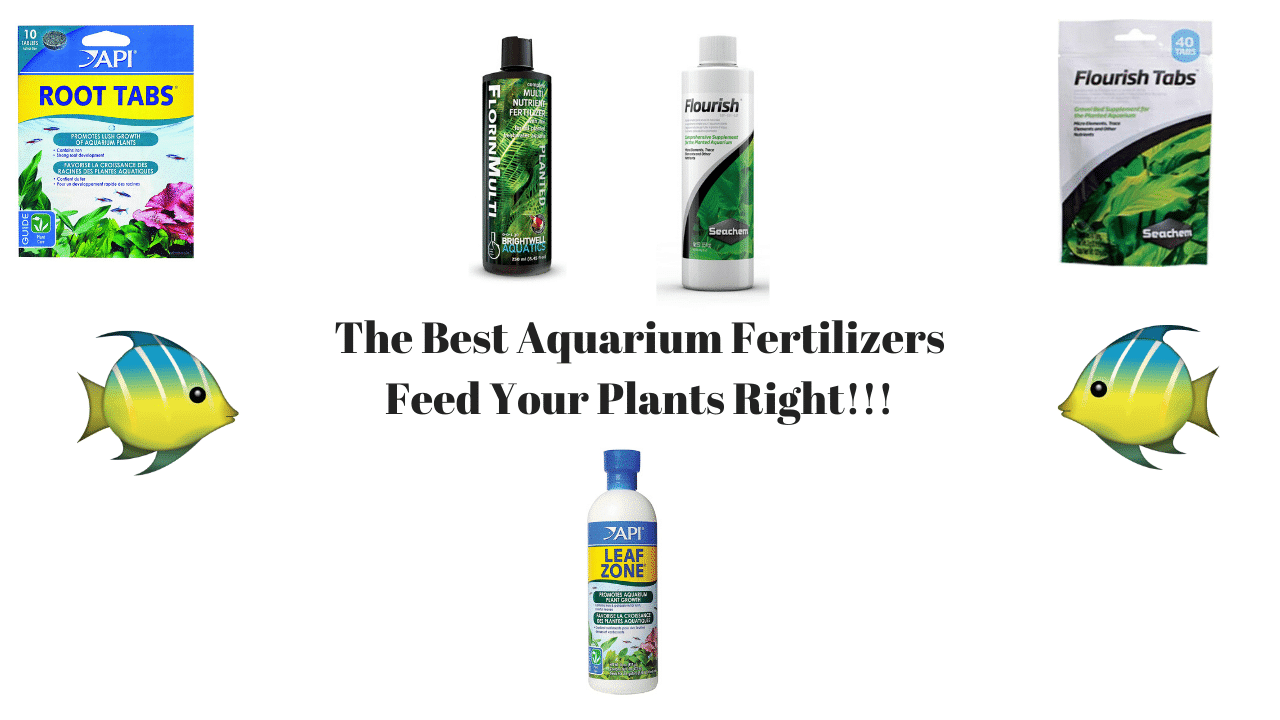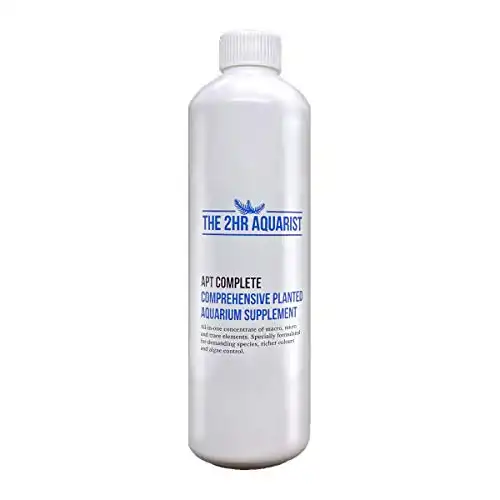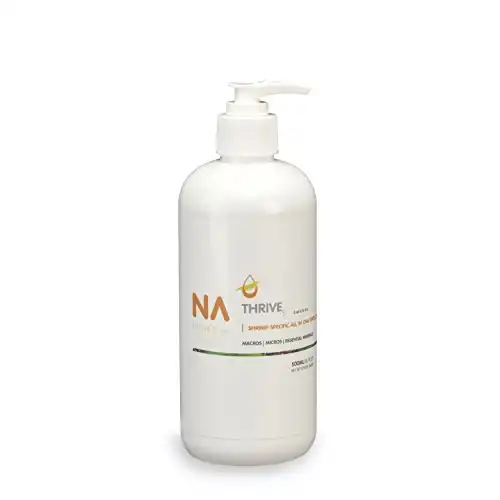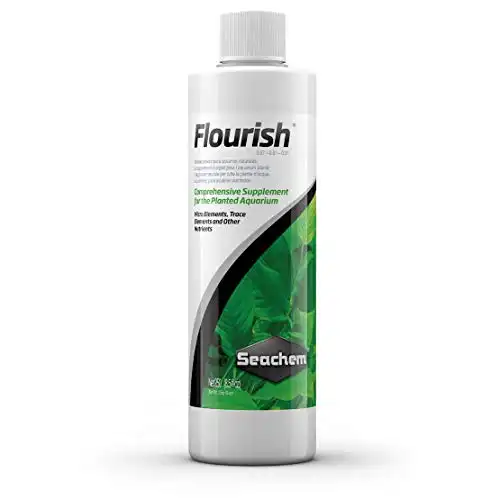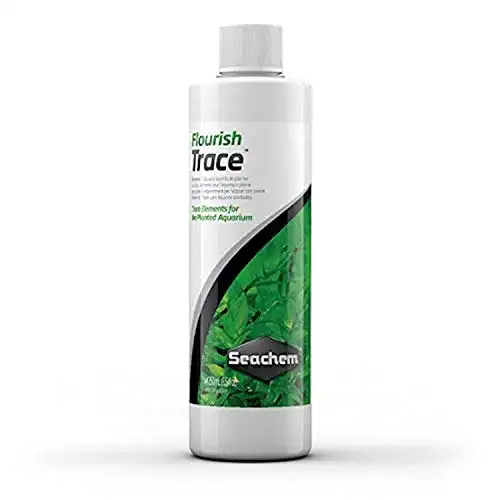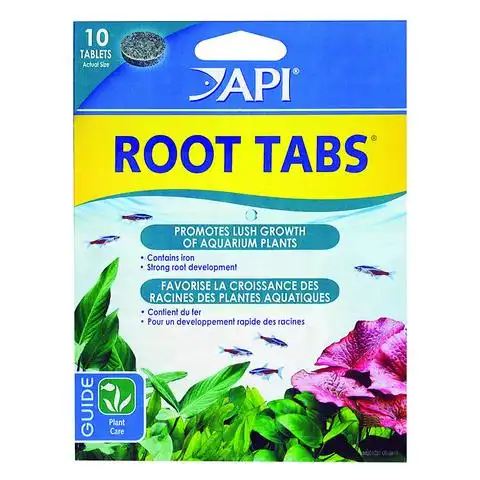Thank you for visiting! By the way… any links on this page that lead to products on Amazon and other stores/partners are affiliate links Aquarium Store Depot earns a commission if you make a purchase.
Are you struggling with finding a quality aquarium plant fertilizer?
In this blog, I share the best aquarium plant fertilizers, from liquid fertilizers to root tabs.
With over 25 years of experience in the aquarium hobby, I’ve assisted countless clients, hobbyists, and readers like you in overcoming their plant growth woes (and believe me, there are a ton of fertilizer products out there). I’ve personally tested these products in real world scenarios to determine the best aquarium plant fertilizer on the market. You can check out the video below from our YouTube Channel.
The Top Picks
Let’s cut straight to the point for those of you in a hurry. My two recommended choices would be Florinmulti as it is readily available at more specialty stores and APT Complete due to how concentrated the mix is. APT is complete fertilizer with everything plants need. You can’t go wrong with either choice and both are designed with planted tank hobbyists in mind. Go with NilocG’s formula if you are keeping a shrimp tank.
Knowing all of this, I still feel in order to get the best results with fertilization, that you should consider CO2 Injection in your aquarium as that will significantly enhance the growth of your plants and will make fertilization far more effective. When the CO2 levels are higher and stable in your planted tank system, your plants will take off with the available CO2 for them to utilize. The fertilizers they will then use will fuel their growth further.
The Candidates – A Quick Comparison
Now, let’s get started with fertilizer recommendations. I’m going to provide both liquid fertilizers and root tabs and explain further as I go through each product.
| Picture | Name | Features | Link |
|---|---|---|---|
Editor’s Choice! 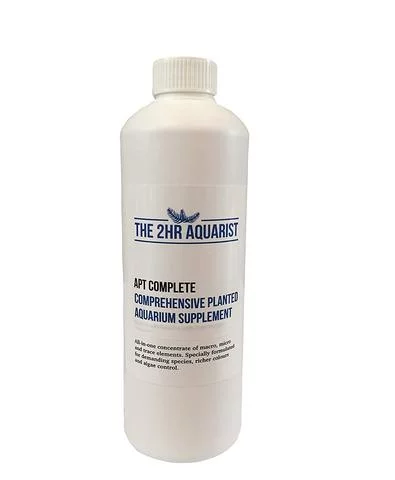 |
| Click For Best PriceBuy On Amazon | |
Best For Dosing  |
| Buy On Amazon | |
Ideal For Shrimp 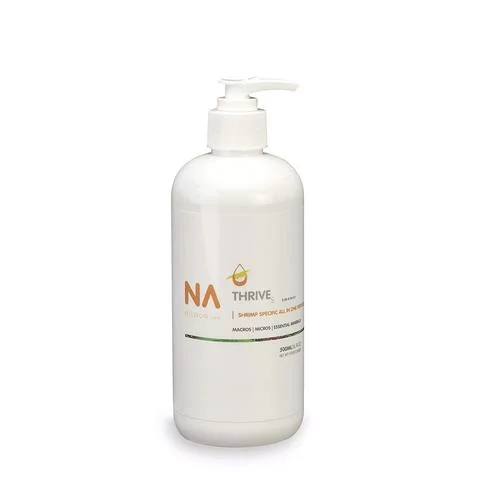 |
| Buy On Amazon | |
 |
| Buy On Amazon | |
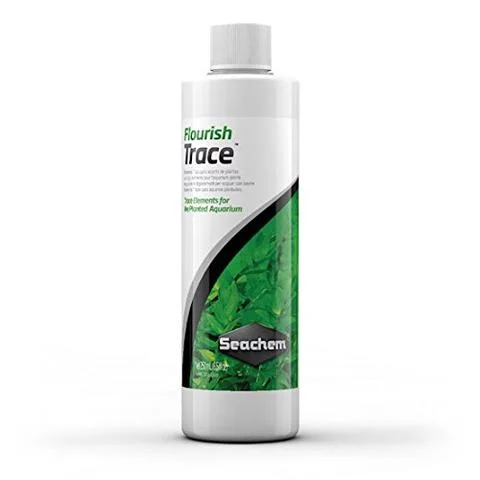 |
| Buy On Amazon | |
 |
| Buy On Amazon | |
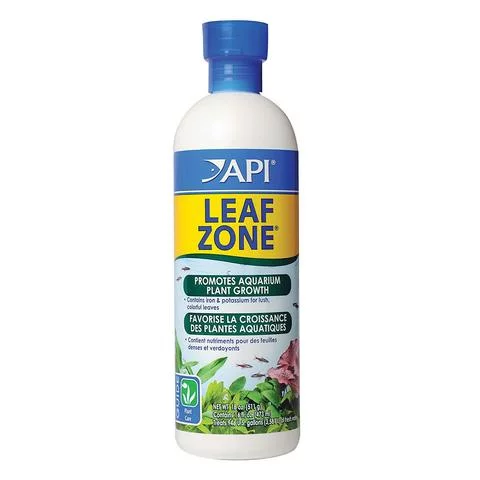 |
| Buy On ChewyBuy On Amazon | |
 |
| Buy On ChewyBuy On Amazon |
The Top 8 Products (2023 Reviews)
Let’s take a lot at each plant fertilizer and see why they made the cut
1. APT Complete – for Serious Planted Tank Enthusiasts
Editor's Choice
Made by an aquascaper for aquascapers. This is the best all around aquarium plant fertilizer on the market. Marco and micronutrients in one bottle!
Use Coupon Code ASDComplete for 10% off your order!
APT Complete is the comprehensive planted aquarium plant fertilizer to use for enthusiasts. It is designed for demanding aquarium plants by a demanding planted tank expert that is research backed. The key here is the concentrate of this formula. Just 1ML per 20 liters adds the following nutrients:
- 1.5PPM Nitrogen
- 0.7 PPM Phosphorous
- 4 PPM Potassium
- 0.3 PPM Iron
- 0.4 PPM Magnesium
This concentrate is at a higher level than many of the branded fertilizers on this list and is truly designed for those with high demanding tanks. That means not only will you save on fertilizer, but you will grow successfully as well. It is also shrimp friendly as it has a low amount of copper compared to other brands.
This is a liquid fertilizer product that is not well known in the industry as they maker of the product is in Singapore. You will not find this product in most stores. It’s worth it’s price in gold. It comes with everything aquarium plants need in one bottle. It is the best all in one aquarium plant fertilizer I’ve seen on the market. And to top it all off, you can use the offer code ASDComplete for a cool 10% off. What are you waiting for!
Pros
- Designed for planted tank enthusiasts
- Saves money in the long run
- Shrimp tank friendly
- Has everything plants need
Cons
- Not available in most stores
- Need to be careful with low tech tanks due to concentration
2. Brightwell Aquatics Florinmulti – Advanced Comprehensive Supplementation
A comprehensive fertilizer solution that is more available at local fish stores. Works for all planted tanks
I know Brightwell Aquatics from their saltwater products, but their freshwater products are also pretty amazing. This Florinmulti aquarium plant fertilizer is a great mix of macro and mico nutrients that will make your aquatic plants thrive. Brightwell’s name in the industry is well know and they do their research on their products. It’s an easy to use product.
The main thing that Brightwell did with this liquid fertilizer product is not include phosphate and nitrogen in their supplement. I actually liked how they did this because nitrate and phosphate supplementation can be done separately and can be controlled. Phosphate and nitrate are very dependent on your bio-load and I feel that Brightwell made the right choice excluding it from their brand. As with many brightwell products, it is a premium price product.
Pros
- Contains 14 elements
- Brightwell name brand
- Easy to use
Cons
- Does not contain nitrogen or phosphate
- Expensive
3. NilocG Aquatics – for Shrimp Tanks
An aquarium plant fertilizer specifically designed for shrimp tanks
NilocG Aquatics Shrimp Specific Fertilizer is a great choice for those with Freshwater Shrimp Tanks. Supplementation for shrimp like Cherry or Amano Shrimp is more specific than for fish because you have to be careful of copper levels and this fertilizer keeps that in mind by not including copper in its mix. I’m always a fan of aquarium plant fertilizers that provide a guaranteed analysis and this product has good numbers.
This liquid fertilizer product is very safe to use with shrimp. NilocG sells the best aquarium plant fertilizers for shrimp tanks on the list.
Pros
- Specifically make for shrimp tanks
- Product has guaranteed analysis
Cons
- Expensive
4. Seachem Flourish – Entry Level Supplementation for Planted Tanks
An easy to use entry level fertilizer for freshwater planted tanks. Readily available at most stores
Seachem Flourish is a common supplement you will see in the retail stores when looking for an aquarium plan fertilizer. It’s very easy to use and beginner friendly due to the light amount of nutrients it contains. This makes Seachem Flourish ideal for the beginner and for those with low light or low tech planted tanks. It is readily available and Seachem has a brand name behind their product.
Pros
- Ideal for low light/low tech planted tanks
- Easy to use
- Readily available
Cons
- Contains little phosphate and nitrate
- You will use the bottle quickly
5. Seachem Flourish Trace – Trace Element Supplementation for Planted Tanks
A great aquarium fertilizer for getting essential trace elements into your planted tank. Readily available in stores
Seachem Flourish Trace a product that includes a variety of trace elements like Boron, Manganese, and Copper. Because this product only contains trace elements – it makes it easier to use with other products like nitrate, phosphate, iron supplements so you can be extra accurate. SeaChem Flourish Trace is a readily available aquarium plant fertilizer product at stores making this easy for you to pick up if you are in a jam.
It does contain copper though, so keep that in mind if you keep a shrimp tank.
Pros
- Trace elements only – good for supplementation
- Easy to use – Beginner friendly
Cons
- Contains copper – not safe for shrimp tanks
- Runs out quick
6. Seachem Flourish Tabs – Great Choice for Rooted Plants
Root tabs like Seachem Flourish are great for planted tanks with inert substrates. These tabs work by placing them down in your substrate around the roots of your aquarium plants like Amazon Swords. The Seachem Flourish product has all the major and minor elements needed to feed your aquarium plants. It’s a comprehensive fertilizer, but it is designed for beginner planted tanks. Those with higher demand aquarium plants and bigger planted tank loads may want to look at other fertilizers or may want to separate out some of the main macros like nitrate and phosphate.
Pros
- Easy to use
- Readiliy available
- Has the all the elements you need
Cons
- Designed as a catch all for all tanks – not for high demanding tanks
- Only suited for rooted aquatic plants
7. API Leaf Zone – Budget and Beginner Friendly Supplementation
Contains iron and potassium. Best suited for heavily stocked aquariums or low tech plant setups. Easy for beginners to use
If you head off to your local pet store, API Leaf Zone will likely be the aquarium plant fertilizer product that you will find there. It is readily available in most stores and is a pretty cheap product. It contains iron and potassium, two of the nutrients we listed earlier that are not produced by livestock or come from source water. Because it does not include other nutrients, the product assumes that you have a heavy bio-load that will produce the other essential nutrients in your aquarium.
This supplement is best for what we call “low-tech” planted tanks. These are tanks that contain Low Light Plants and aquatic plants that are easy to care for. Because it only contains two nutrients, it is beginner friendly to use.
Pros
- Cheap
- Readily available
Cons
- Runs out fast
- Only contains potassium and iron
8. API Root Tabs – Supplementation for Heavy Bio-Load Tanks
API Root Tabs are likely going to be the most readily available root tab that you will find in stores. It is a very easy to use product and it contains iron. It is relevantly cheap making it an easy to afford for newcomers to planted tanks. Because it is a tabbed product, it is not ideal for aquatic plants that feed off the water column so know this before using.
The main drawback for me is there is no guaranteed analysis on the product. This can be frustrating for those who want to dial in their dosing routines.
Pros
- Easy to use
- Contains Iron
- Cheap
Cons
- Not for water column feeding plants
- No guaranteed analysis info
Macro and Micro Nutrients for Aquarium Plants – What Are They?
We are going to start with the nutrients that aquatic plants need. Aquatic plants like terrestrial plants require a variety of nutrients to grow and thrive. These nutrients are split into two groups – macro and micro nutrients
Macro Nutrients
Macros nutrients make up the majority of your aquarium plant’s mass. These nutrients will come either from your water column or your Aquarium Substrate. We can split up these macro nutrients into the following:
- Carbon
- Nitrogen
- Phosphorous
- Potassium
Carbon
Carbon is the big chuck of the equation. Plants need carbon. It makes up 40% of your plant’s dry mass. As I mentioned in our Best CO2 System for Planted Aquarium post, the fact that carbon is such a big part of your plant’s mass is why CO2 supplementation makes such a giant impact on your plant growth. With higher CO2 levels, you can scale up your nutrient requirements and accelerate the growth and improve the health of your aquatic plants by leaps and bounds. We want to aim for 30PPM of CO2.
Nitrogen
Nitrogen levels will have impact on your plant growth rates. When it is very limited it can cause growth rates to halt and plants to become brittle. In green plants, low levels will lead to yellowing of the leaves. It can also enhance the reds of some plants at lower levels. Nitrogen can be made available from livestock if the bio-load if significant.
Phosphorous
This is an often under-dosed nutrient. PO4 plays a big role in the energy systems if plants. If you have an ideal amount of PO4 in your aquarium, an aquatic plant will be more robust and will display better colors. Phosphorus can be made available from livestock if the bio-load if significant.
Potassium
Potassium helps with the metabolism of your plants. Without it, your plant health will deteriorate cause visible issues like pinholes or brittle leaves. Potassium is not produced by your livestock in your aquarium and is not usually available from your water. It requires dosing to maintain ideal levels.
Micro Nutrients
Micro nutrients are nutrients that are required by your aquatic plants in lesser amounts, but are critical to your plant’s success. Micro Nutrients are:
- Iron
- Manganese
- Trace Elements
Iron
Iron is important for chlorophyll production. Without the proper amount of iron, plants can be afflicted with clorosis in the leaves (aka yellowing of leaves). Iron is neither available from livestock or your source water. It requires dosing to maintain proper levels.
Manganese
Manganese is part of the photosynthesis process. When levels are lacking, this will affect the ability to take in macro nutrients. Like Iron, this must be dosed in order to maintain levels.
Trace Elements
These would include things like Magnesium, Boron, Zine, Copper, Cobalt, etc. They can be contained in source water, but often times are required to be dosed to maintain levels.
Types of Aquarium Fertilizers
Aquarium fertilizers come in a variety of form. They are:
- Substrates
- Liquid Fertilizers
- Root Tabs
Substrates
An active substrate like ADA Aquasoil will act as its own fertilizer being a source of nutrients for your aquatic plants. They are great for getting your planted aquariums started. They will degrade over time. This requires you to replace the substrate over time and increase dosing as it breaks down. You will not need to use an active substrate if you have plants that are column feeders. This is because column feeders cannot access the nutrients in your substrate.
Liquid
Liquid Fertilizers are the standard plant fertilizer you will see. They are easy to use and distribute. They can both be feed into the water column and injected into the substrate. This give them the advantage of being able to feed both column and root feeders.
Root Tabs
Roots Tabs are designed for root plants. If you have a large amount of aquarium plants that feed through their root system, Rooted tabs can be very useful in delivering the nutrients they need to continue to thrive and grow. Root tabs will not be useful for aquatic plants that feed off your water column.
Should You Dose These Products?
The quick answer is yes, if you want to have the best growth and coloration of most plant species.
Because your aquarium is a closed environment, there is not a natural cycle of renewal of nutrients. Our substrates and soil eventually will delete and other nutrients will be removed via water changes over time. There are also elements in that cannot be replaced with source water or produced by livestock as mentioned above. A planted tank can definitely grow without fertilization, but they will not achieve the best plant growth. You are in summary, not allowing your aquarium to live to its full potential. We want our environments and pets to thrive and give them the best, so fertilization is there to provide an ideal environment.
We proper levels, your aquatic plants will grow more dense, with better color, and will remain healthy.
Understanding The Three Elements of Aquatic Greenery Success
We are covering one of the elements today. There are three of them for planted tank success and they are:
- Proper Planted Tank Lighting
- A Good Planted Aquarium Substrate
- Aquarium Fertilizers
Fertilizers are probably the most difficult to understand and easiest to ignore. It’s also easy to under and overdose! Below is a picture from aquaticplantcentral’s forum to give you an overview on plant nutrient deficiencies as a quick reference.

Getting familiar with the photo above will help you diagnose issues in your planted tank as your plants will give you visual queues and signs on what they are lacking in the aquarium.
Frequently Asked Questions
Below are common questions I get from readers and clients. If you have any you free I missed, please leave a comment below and I can update the post to including the additional question and answer.
What Are The Parameters I Should Be Maintaining In A Planted Tank?
This is a loaded question, but assuming you run a higher light and CO2 system, these would be figures you would generally aim for in a planted tank. You can use Aquarium Test Kits to monitor your levels:
| Parameter | Level |
| Ammonia | 0 PPM |
| Nitrite | 0 PPM |
| GH (General Hardness) | 2-8 dGH |
| KH (Carbonate Hardness) | 3-6 dKH |
| pH | 6.5 – 7.0 |
| N03 (Nitrate) | 5 – 10 PPM |
| CO2 | 20 – 30 PPM |
| PO4 (Phosphate) | 0.2 – 0.5 PPM |
| Fe (Iron) | 0.2 – 0.7PPM |
Why Do You Not Recommend API Leaf Zone and Flourish?
Unlike other sites or bloggers you may have visited I do not recommend API Leaf Zone or Flourish for serious planted tank owners. API Leaf Zone only contains Potassium and Iron. It is designed for a low tech planted tank and lacks the macro nutrients needed for serious grow in a full blown planted tank that is running CO2.
Flourish on the other hand is an entry level dosing product. It contains little nitrate and phosphate. This allows for forgiveness if you overdose or not sure what you are doing at first. When you have a full planted tank with lots of hungry plants, you will go through this product quickly.
Both the Brightwell and APT products are designed for planted tank owners will full planted tanks running off CO2 systems. They are designed for serious hobbyist who want big time growth. API Leaf Zone and SeaChem Flourish are entry level products for when you start out. When you are ready to graduate you can use Brightwell and APT. Most of the time, I just tell folks to go with Brightwell or APT right away knowing their goals are a full planted tank with CO2.
What About CO2 Boosters?
CO2 boosters are great for low light and low tech planted tanks. I would only recommend them for those setups. A CO2 booster product like API CO2 Booster will work on these low light and low tech setups. All planted aquariums will welcome a boost in CO2 levels regardless of what types of plants you put into your system.
The issue with CO2 boosters is outside of a low light or low tech planted tank. When you get into setups that have full tanks of hungry and fast growing plants, they will require constant CO2 levels. You will struggle to maintain stable CO2 levels in a fully planted tank, especially if you decide to make a high demand planted aquascape like say an Dutch Aquascape. A CO2 Booster simply will not do with these setups. I would recommend a CO2 system if your long term plan is a fully planted tank or if you want an advanced aquascape setup.
Are They Bad for Fish?
Fertilizers are not bad for fish in general. The main parameter we may have to keep an eye on is nitrates if we are housing particularly sensitive fish like say Discus. Fertilizers encourage plant grow, which in turn will increase the quality of your water. It will increase the natural look of your aquarium and provide shelter for your fish. Large plants will reduce aggression and decrease stress levels. For some fish, it will produce a food source for them. There is virtually no drawback to your tank health if you use fertilizers properly as healthy plants is healthy for all the inhabitants in your tank.
How Do I Dose Liquid Products?
If you are using an all-in-one fertilizer like we are recommending, your job should be fairly easy. We should follow the instructions on the bottle, in which both APT and Brightwell offer clear guidelines on how much to dose. Pour the suggested dosage in the cap or a small container and release the fertilizer to the outlet of your tank. Before you recap the bottle make sure you dip the cap in your aquarium water to rinse off. This will keep your cap from crusting over time.
Experienced planted tank owners prefer to dose everyday. It is better for your planted to have sustained stable levels in your tank. Dosing once a week with a big dosage can lead to unstable levels, which will hurt the potential grow you can get if you dosage smaller and constantly everyday.
When Should I Dose My Tank?
You should fertilize as soon as your tank is cycled and your plants are actively growing. It is best to dose every day. It is best to dose all in one day.
Do These Products Increase Nitrates?
It most certainty can. It depends on the fertilizer. It is best to follow your manufacturer’s instructions and monitor your levels via a test kit. You may need to adjust overtime as your plants grow.
Do Planted Tanks Need Fertilizer?
Yes, aquarium plants should be given fertilizer. However, the need to fertilizer does not trump the need for higher CO2 levels. The effectiveness of plant growth goes CO2 > Lighting > Fertilizer. You need to balance all three, but you will get greater initial plant growth going with CO2 first. If you have a good aqua soil, you will generally get a good fertilizer boost to start.
Closing Thoughts
Aquarium plant fertilizers are 1 of 3 major components of planted tank success with lighting and substrates being the other. I hope I helped to point you in the right direction on what fertilizer is right for you and your budget. If you have any questions, feel free to leave a comment below. Thanks for reading!
- About the Author
- Latest Posts
I’m thrilled that you found Aquarium Store Depot! Here you’ll find information on fish, aquariums, and all things aquatics related. I’m a hobbyist (being doing this since I was 11) and here to help other hobbyists thrive with their aquariums! I adhere to a high quality Editorial Process and Review products with real life field usage and practical analysis.

